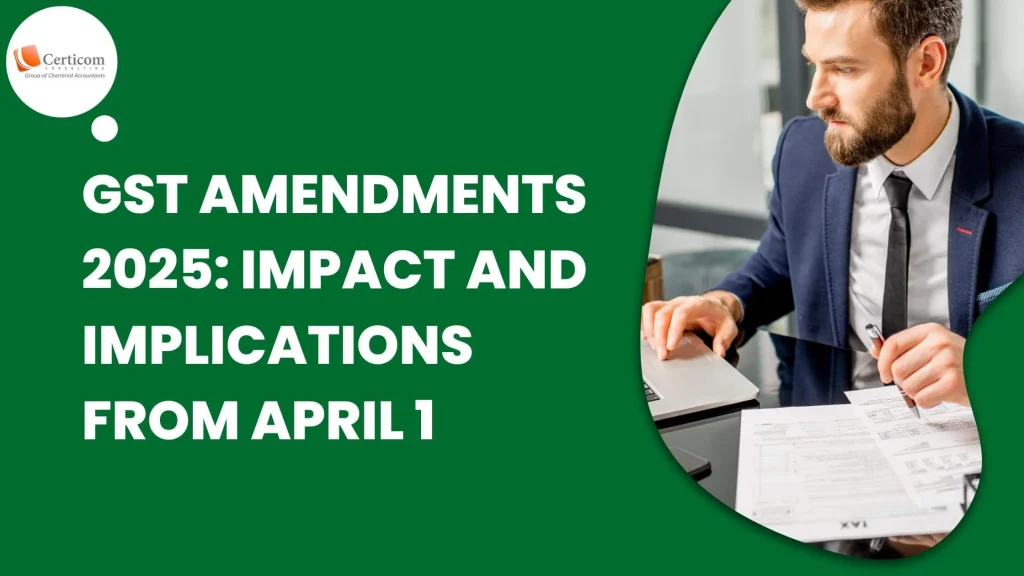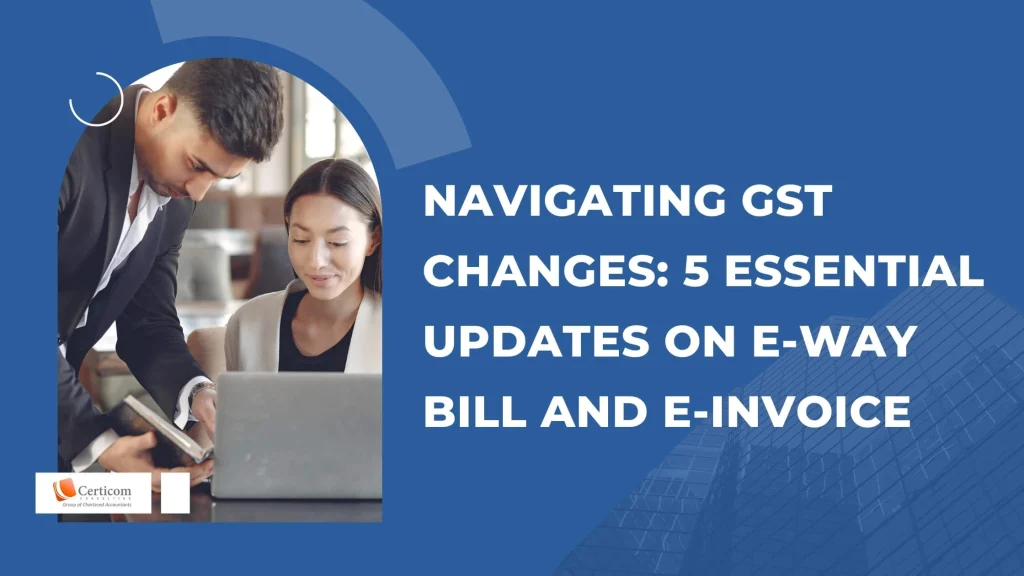- Have any questions?
GST Amendments 2025: Impact and Implications from April 1

As the Goods and Services Tax (GST) regime approaches its eighth anniversary since its launch on July 1, 2017, the framework continues to evolve in response to compliance needs, technological advancements, and stakeholder feedback. The latest amendments coming into effect from April 1, 2025, mark a significant milestone in this journey—bringing major procedural and operational reforms that impact taxpayers, businesses, and tax professionals alike.
These reforms are aimed at enhancing compliance, tightening security, simplifying tax administration, and fostering accountability across all levels. Let’s explore eight major GST amendments that come into force this financial year and examine their legal basis, practical implications, and anticipated benefits.
Mandatory Multi-Factor Authentication (MFA) for All Taxpayers
To strengthen data security and prevent unauthorized access, MFA is now compulsory for all users accessing the GST portal, effective April 1, 2025. Earlier implemented in phases for larger taxpayers, this security feature is now applicable to everyone.
Legal Basis: Section 146 of the CGST Act, 2017
Authentication Methods: Password + OTP via SMS, Sandes App, or NIC-GST-Shield App
Rollout Timeline:
₹20 Cr+ turnover: From Jan 1, 2025
₹5 Cr+ turnover: From Feb 1, 2025
All others: From April 1, 2025
Benefits:
Enhanced data protection
Fraud prevention
Improved user accountability
Global cybersecurity alignment
Greater trust in the digital tax system

Upgraded E-Way Bill & E-Invoice Systems with Validity Restrictions
To ensure timeliness and transparency in goods movement, E-Way Bills can now only be generated for invoices issued within the last 180 days, with an overall cap of 360 days. Enhanced E-Way Bill and e-Invoice platforms will also include mandatory 2FA authentication.
Legal Basis: Section 68 of the CGST Act, 2017
Key Change: Restriction on backdated invoices and phased implementation of 2FA for all users
Implications:
Stronger checks against fake invoicing
More efficient monitoring and analytics
Discourages prolonged warehousing of goods
Environmentally sustainable operations
Sequential Filing Now Mandatory for GSTR-7 (TDS Returns)
Starting Nov 1, 2024, Tax Deductors must file GSTR-7 returns in chronological order without skipping periods. Even Nil returns must be filed to maintain sequence.
Legal Basis: Section 51, Rule 66, Notification No. 17/2024
Targeted Entities: Government departments, PSUs, corporations deducting TDS under GST
Advantages:
Improved TDS tracking and reconciliation
Smoother audits with uninterrupted data trails
Minimization of return filing inconsistencies
Biometric Authentication for Directors of Companies
To curb fraudulent registrations, company directors must complete biometric authentication at any GST Suvidha Kendra in their home state.
Legal Basis: Section 25; Rule 8 & 9 (Amended via Notification No. 20/2025)
Available From: March 4, 2025
Scope of Authentication:
Fingerprints, facial recognition, photo, and document verification
Key Benefits:
Prevention of fake registrations
Enhanced identity verification
Easier registration process across states
Aligns GST KYC with banking norms
Mandatory Input Service Distributor (ISD) Mechanism
From April 1, 2025, the ISD mechanism is mandatory for allocating ITC on shared services like rent, advertising, and professional fees across multiple GST registrations under a single PAN.
Legal Basis: Section 20; Rule 39 & 54 (Notification No. 21/2025)
Services Covered: FCM & RCM-based common input services
Expected Outcomes:
Equitable and accurate ITC distribution
Consistent practices across organizations
Reduced working capital needs
Better transparency and audit readiness
GST Rate Changes for Hotels and Used Cars
For Hotels:
Declared Tariff abolished; tax based on actual transaction value
18% GST for room tariffs above ₹7,500/day
Full Input Tax Credit (ITC) eligibility
For Used Cars:
Uniform GST rate of 18% on margin value for all categories
Differential rates (12% for small cars, EVs) eliminated
Legal Basis: Rule 32(5) of CGST Rules, 2017
Positive Impacts:
Simplified valuation and compliance for hotels
Level playing field for the used car industry
Increased transparency and fair tax practices
Enhanced revenue collection for the government
New Invoice Series Requirement
Effective April 1, 2025, all taxpayers must initiate a new invoice series for the financial year. The series must be unique, sequential, and non-repetitive.
Key Guidelines:
Separate series for different types (invoice, credit note, etc.)
ERP systems must be updated accordingly
Applicable to all e-invoicing eligible taxpayers (AATO > ₹5 Cr)
Purpose:
Improve auditability
Standardize invoicing processes
Prevent duplication and discrepancies

GST Waiver Scheme 2024 – Relief for Legacy Dues
A one-time GST Amnesty Scheme provides a waiver of interest and penalty for FY 2017–18 to 2019–20, subject to 100% payment of tax dues by March 31, 2025.
Legal Basis: Section 128A of the CGST Act, 2017
Application Forms: SPL-01 / SPL-02
Deadline: Apply by June 30, 2025
Why It Matters:
Enables resolution of long-standing disputes
Encourages voluntary compliance
Reduces financial and litigation burden for honest taxpayers
Strengthening Compliance While Easing Operations
The GST amendments effective April 1, 2025, signal a balanced approach by the government—tightening security and enforcement on one hand while simplifying procedures and offering relief on the other. While these reforms will demand greater diligence from taxpayers, they also enhance trust, transparency, and efficiency in the overall tax ecosystem.
For businesses, professionals, and tax administrators alike, adapting early and updating internal systems will be key to smooth compliance. These timely changes are a testament to India’s commitment to evolving GST into a more mature, resilient, and globally aligned tax regime.
Related Post
Pros and Cons of Presumptive Taxation Scheme for Professionals
Understanding Form 3CD Amendments: What Changed from April 1, 2025
Book A One To One Consultation Now For FREE
How can we help? *




